Critical Analysis Essay: Bisoprolol and Heart Failure Treatment
VerifiedAdded on 2022/08/21
|19
|5382
|14
Essay
AI Summary
This essay offers a critical analysis of bisoprolol, a beta-blocker drug, and its efficacy in treating heart failure and renal impairment. The analysis begins with an introduction to the drug, its classification, and its use in managing hypertension and heart failure, often associated with renal impairment. The essay delves into the pathophysiology of heart failure, explaining how factors like damaged heart muscles, blood vessel issues, and the renin-angiotensin system contribute to increased heart rate and blood pressure. The pharmacology section explores bisoprolol's mechanism of action, which involves blocking beta-1 adrenergic receptors, leading to decreased heart rate, cardiac output, and blood pressure. It discusses side effects, pharmacokinetics (including administration, absorption, metabolism, and half-life), and differences from other beta-blockers. The essay also references key studies like the CIBIS-II trial and other research that support bisoprolol's use in patients with heart failure and renal impairment. The essay concludes by evaluating the evidence base for the drug's use, justifying or challenging its application in specific circumstances.
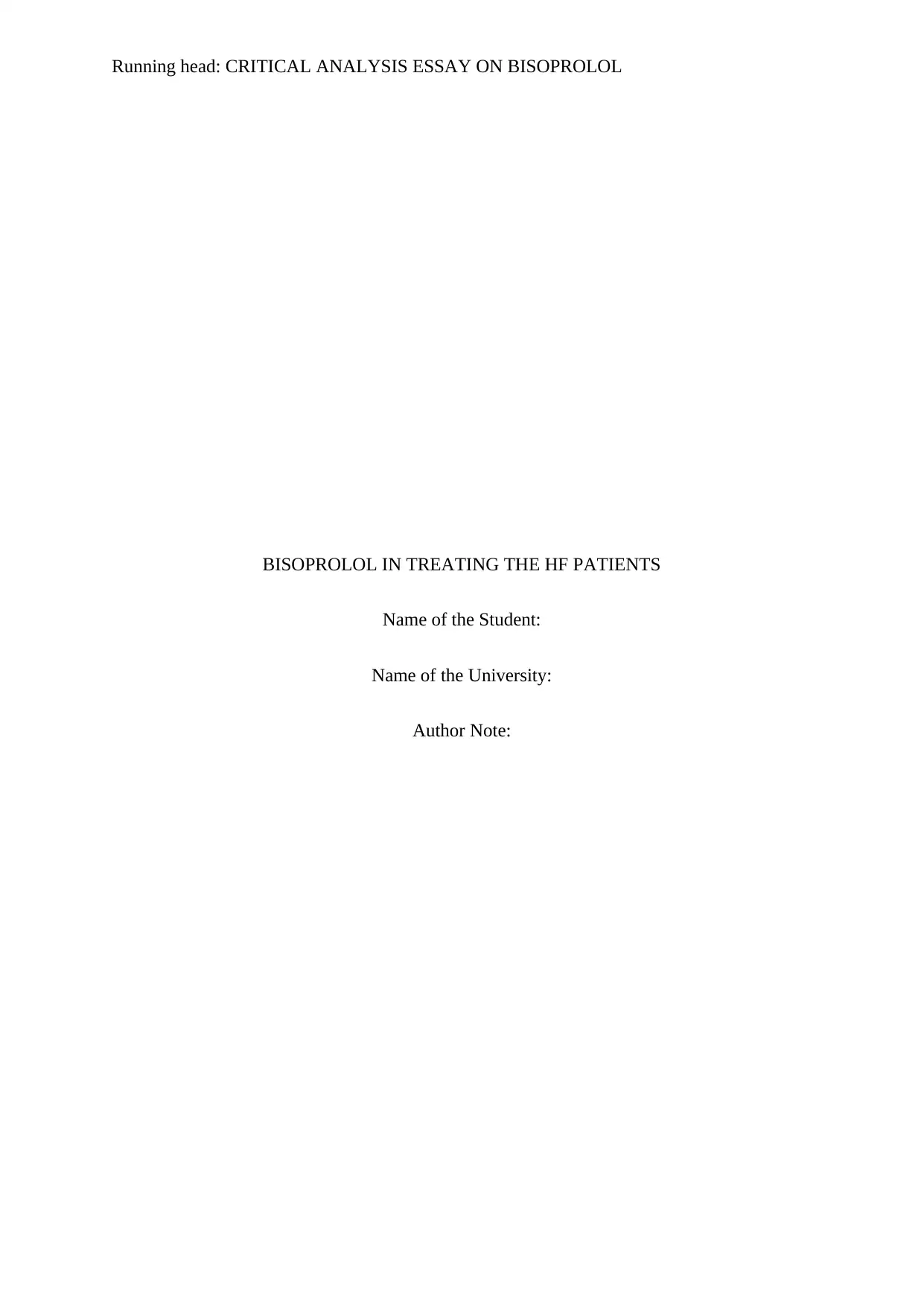
Running head: CRITICAL ANALYSIS ESSAY ON BISOPROLOL
BISOPROLOL IN TREATING THE HF PATIENTS
Name of the Student:
Name of the University:
Author Note:
BISOPROLOL IN TREATING THE HF PATIENTS
Name of the Student:
Name of the University:
Author Note:
Paraphrase This Document
Need a fresh take? Get an instant paraphrase of this document with our AI Paraphraser
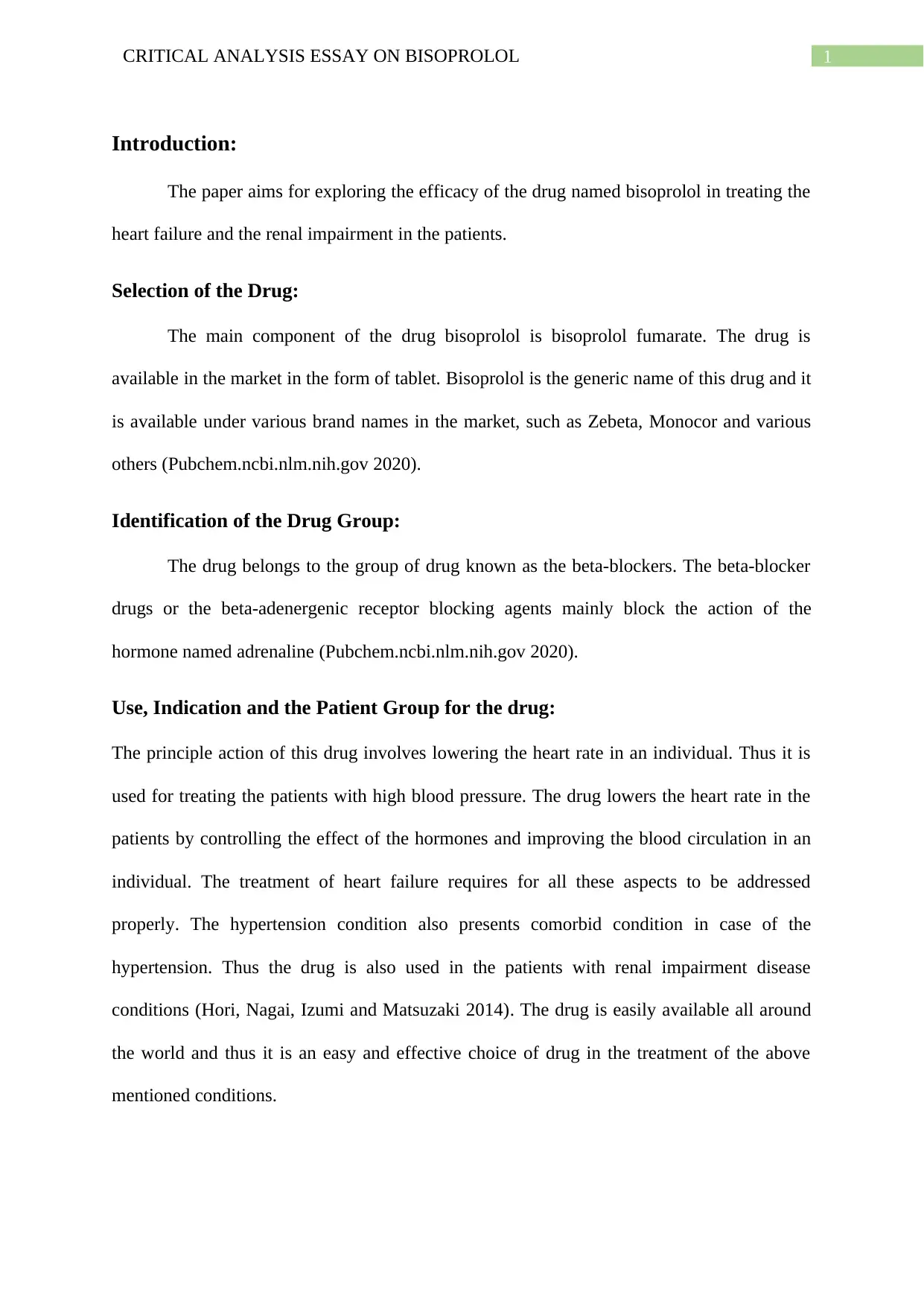
1CRITICAL ANALYSIS ESSAY ON BISOPROLOL
Introduction:
The paper aims for exploring the efficacy of the drug named bisoprolol in treating the
heart failure and the renal impairment in the patients.
Selection of the Drug:
The main component of the drug bisoprolol is bisoprolol fumarate. The drug is
available in the market in the form of tablet. Bisoprolol is the generic name of this drug and it
is available under various brand names in the market, such as Zebeta, Monocor and various
others (Pubchem.ncbi.nlm.nih.gov 2020).
Identification of the Drug Group:
The drug belongs to the group of drug known as the beta-blockers. The beta-blocker
drugs or the beta-adenergenic receptor blocking agents mainly block the action of the
hormone named adrenaline (Pubchem.ncbi.nlm.nih.gov 2020).
Use, Indication and the Patient Group for the drug:
The principle action of this drug involves lowering the heart rate in an individual. Thus it is
used for treating the patients with high blood pressure. The drug lowers the heart rate in the
patients by controlling the effect of the hormones and improving the blood circulation in an
individual. The treatment of heart failure requires for all these aspects to be addressed
properly. The hypertension condition also presents comorbid condition in case of the
hypertension. Thus the drug is also used in the patients with renal impairment disease
conditions (Hori, Nagai, Izumi and Matsuzaki 2014). The drug is easily available all around
the world and thus it is an easy and effective choice of drug in the treatment of the above
mentioned conditions.
Introduction:
The paper aims for exploring the efficacy of the drug named bisoprolol in treating the
heart failure and the renal impairment in the patients.
Selection of the Drug:
The main component of the drug bisoprolol is bisoprolol fumarate. The drug is
available in the market in the form of tablet. Bisoprolol is the generic name of this drug and it
is available under various brand names in the market, such as Zebeta, Monocor and various
others (Pubchem.ncbi.nlm.nih.gov 2020).
Identification of the Drug Group:
The drug belongs to the group of drug known as the beta-blockers. The beta-blocker
drugs or the beta-adenergenic receptor blocking agents mainly block the action of the
hormone named adrenaline (Pubchem.ncbi.nlm.nih.gov 2020).
Use, Indication and the Patient Group for the drug:
The principle action of this drug involves lowering the heart rate in an individual. Thus it is
used for treating the patients with high blood pressure. The drug lowers the heart rate in the
patients by controlling the effect of the hormones and improving the blood circulation in an
individual. The treatment of heart failure requires for all these aspects to be addressed
properly. The hypertension condition also presents comorbid condition in case of the
hypertension. Thus the drug is also used in the patients with renal impairment disease
conditions (Hori, Nagai, Izumi and Matsuzaki 2014). The drug is easily available all around
the world and thus it is an easy and effective choice of drug in the treatment of the above
mentioned conditions.
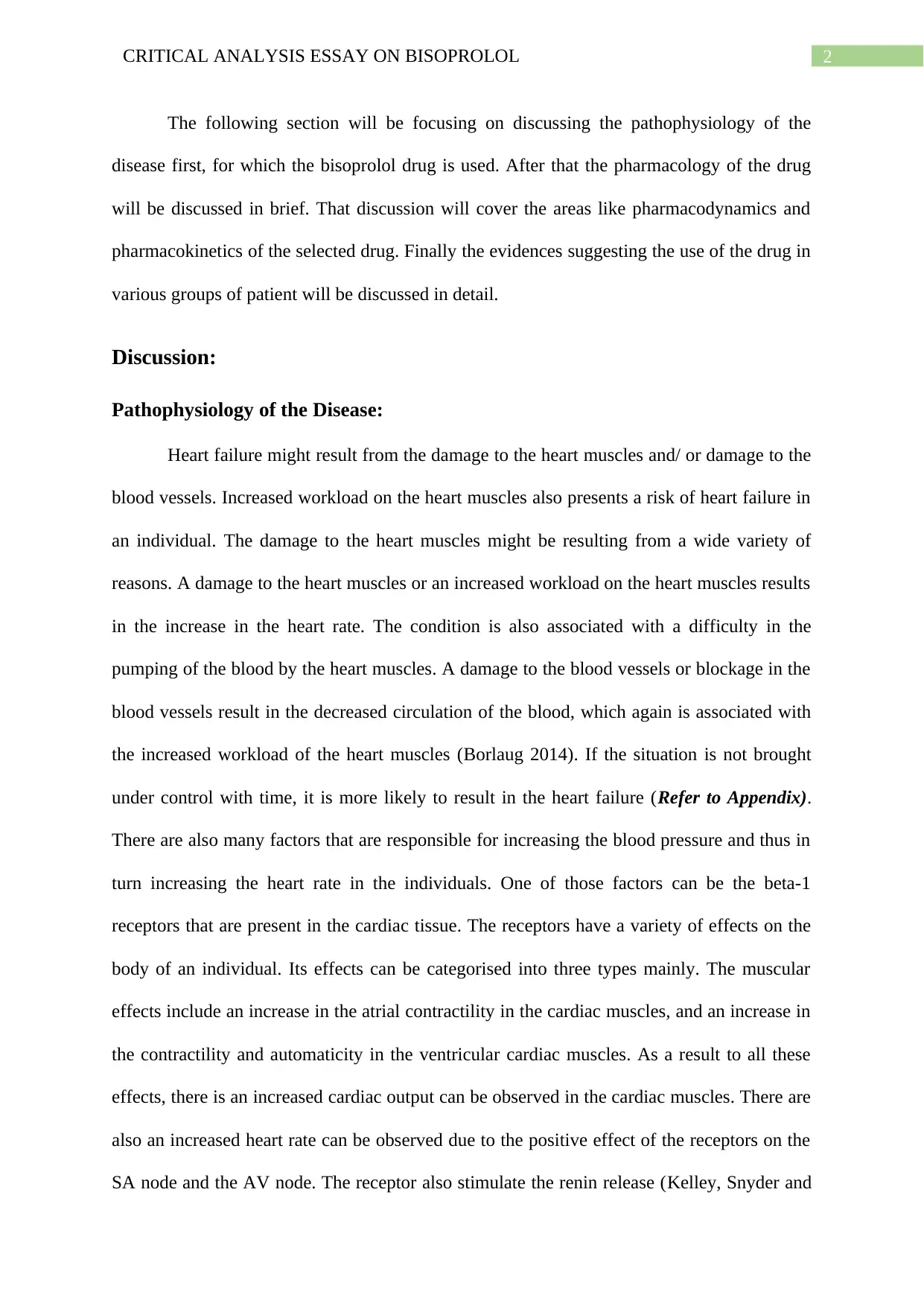
2CRITICAL ANALYSIS ESSAY ON BISOPROLOL
The following section will be focusing on discussing the pathophysiology of the
disease first, for which the bisoprolol drug is used. After that the pharmacology of the drug
will be discussed in brief. That discussion will cover the areas like pharmacodynamics and
pharmacokinetics of the selected drug. Finally the evidences suggesting the use of the drug in
various groups of patient will be discussed in detail.
Discussion:
Pathophysiology of the Disease:
Heart failure might result from the damage to the heart muscles and/ or damage to the
blood vessels. Increased workload on the heart muscles also presents a risk of heart failure in
an individual. The damage to the heart muscles might be resulting from a wide variety of
reasons. A damage to the heart muscles or an increased workload on the heart muscles results
in the increase in the heart rate. The condition is also associated with a difficulty in the
pumping of the blood by the heart muscles. A damage to the blood vessels or blockage in the
blood vessels result in the decreased circulation of the blood, which again is associated with
the increased workload of the heart muscles (Borlaug 2014). If the situation is not brought
under control with time, it is more likely to result in the heart failure (Refer to Appendix).
There are also many factors that are responsible for increasing the blood pressure and thus in
turn increasing the heart rate in the individuals. One of those factors can be the beta-1
receptors that are present in the cardiac tissue. The receptors have a variety of effects on the
body of an individual. Its effects can be categorised into three types mainly. The muscular
effects include an increase in the atrial contractility in the cardiac muscles, and an increase in
the contractility and automaticity in the ventricular cardiac muscles. As a result to all these
effects, there is an increased cardiac output can be observed in the cardiac muscles. There are
also an increased heart rate can be observed due to the positive effect of the receptors on the
SA node and the AV node. The receptor also stimulate the renin release (Kelley, Snyder and
The following section will be focusing on discussing the pathophysiology of the
disease first, for which the bisoprolol drug is used. After that the pharmacology of the drug
will be discussed in brief. That discussion will cover the areas like pharmacodynamics and
pharmacokinetics of the selected drug. Finally the evidences suggesting the use of the drug in
various groups of patient will be discussed in detail.
Discussion:
Pathophysiology of the Disease:
Heart failure might result from the damage to the heart muscles and/ or damage to the
blood vessels. Increased workload on the heart muscles also presents a risk of heart failure in
an individual. The damage to the heart muscles might be resulting from a wide variety of
reasons. A damage to the heart muscles or an increased workload on the heart muscles results
in the increase in the heart rate. The condition is also associated with a difficulty in the
pumping of the blood by the heart muscles. A damage to the blood vessels or blockage in the
blood vessels result in the decreased circulation of the blood, which again is associated with
the increased workload of the heart muscles (Borlaug 2014). If the situation is not brought
under control with time, it is more likely to result in the heart failure (Refer to Appendix).
There are also many factors that are responsible for increasing the blood pressure and thus in
turn increasing the heart rate in the individuals. One of those factors can be the beta-1
receptors that are present in the cardiac tissue. The receptors have a variety of effects on the
body of an individual. Its effects can be categorised into three types mainly. The muscular
effects include an increase in the atrial contractility in the cardiac muscles, and an increase in
the contractility and automaticity in the ventricular cardiac muscles. As a result to all these
effects, there is an increased cardiac output can be observed in the cardiac muscles. There are
also an increased heart rate can be observed due to the positive effect of the receptors on the
SA node and the AV node. The receptor also stimulate the renin release (Kelley, Snyder and
⊘ This is a preview!⊘
Do you want full access?
Subscribe today to unlock all pages.

Trusted by 1+ million students worldwide
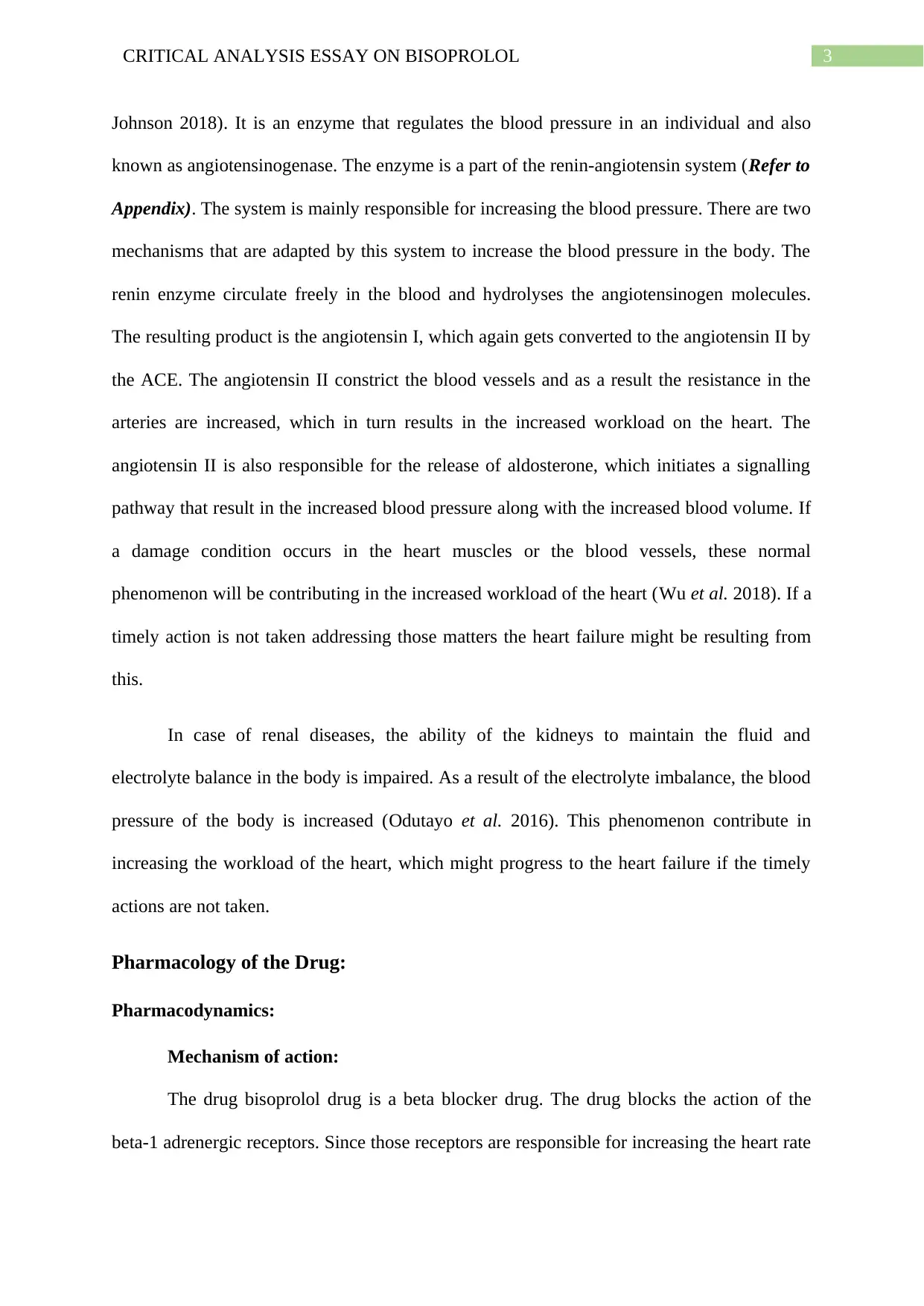
3CRITICAL ANALYSIS ESSAY ON BISOPROLOL
Johnson 2018). It is an enzyme that regulates the blood pressure in an individual and also
known as angiotensinogenase. The enzyme is a part of the renin-angiotensin system (Refer to
Appendix). The system is mainly responsible for increasing the blood pressure. There are two
mechanisms that are adapted by this system to increase the blood pressure in the body. The
renin enzyme circulate freely in the blood and hydrolyses the angiotensinogen molecules.
The resulting product is the angiotensin I, which again gets converted to the angiotensin II by
the ACE. The angiotensin II constrict the blood vessels and as a result the resistance in the
arteries are increased, which in turn results in the increased workload on the heart. The
angiotensin II is also responsible for the release of aldosterone, which initiates a signalling
pathway that result in the increased blood pressure along with the increased blood volume. If
a damage condition occurs in the heart muscles or the blood vessels, these normal
phenomenon will be contributing in the increased workload of the heart (Wu et al. 2018). If a
timely action is not taken addressing those matters the heart failure might be resulting from
this.
In case of renal diseases, the ability of the kidneys to maintain the fluid and
electrolyte balance in the body is impaired. As a result of the electrolyte imbalance, the blood
pressure of the body is increased (Odutayo et al. 2016). This phenomenon contribute in
increasing the workload of the heart, which might progress to the heart failure if the timely
actions are not taken.
Pharmacology of the Drug:
Pharmacodynamics:
Mechanism of action:
The drug bisoprolol drug is a beta blocker drug. The drug blocks the action of the
beta-1 adrenergic receptors. Since those receptors are responsible for increasing the heart rate
Johnson 2018). It is an enzyme that regulates the blood pressure in an individual and also
known as angiotensinogenase. The enzyme is a part of the renin-angiotensin system (Refer to
Appendix). The system is mainly responsible for increasing the blood pressure. There are two
mechanisms that are adapted by this system to increase the blood pressure in the body. The
renin enzyme circulate freely in the blood and hydrolyses the angiotensinogen molecules.
The resulting product is the angiotensin I, which again gets converted to the angiotensin II by
the ACE. The angiotensin II constrict the blood vessels and as a result the resistance in the
arteries are increased, which in turn results in the increased workload on the heart. The
angiotensin II is also responsible for the release of aldosterone, which initiates a signalling
pathway that result in the increased blood pressure along with the increased blood volume. If
a damage condition occurs in the heart muscles or the blood vessels, these normal
phenomenon will be contributing in the increased workload of the heart (Wu et al. 2018). If a
timely action is not taken addressing those matters the heart failure might be resulting from
this.
In case of renal diseases, the ability of the kidneys to maintain the fluid and
electrolyte balance in the body is impaired. As a result of the electrolyte imbalance, the blood
pressure of the body is increased (Odutayo et al. 2016). This phenomenon contribute in
increasing the workload of the heart, which might progress to the heart failure if the timely
actions are not taken.
Pharmacology of the Drug:
Pharmacodynamics:
Mechanism of action:
The drug bisoprolol drug is a beta blocker drug. The drug blocks the action of the
beta-1 adrenergic receptors. Since those receptors are responsible for increasing the heart rate
Paraphrase This Document
Need a fresh take? Get an instant paraphrase of this document with our AI Paraphraser
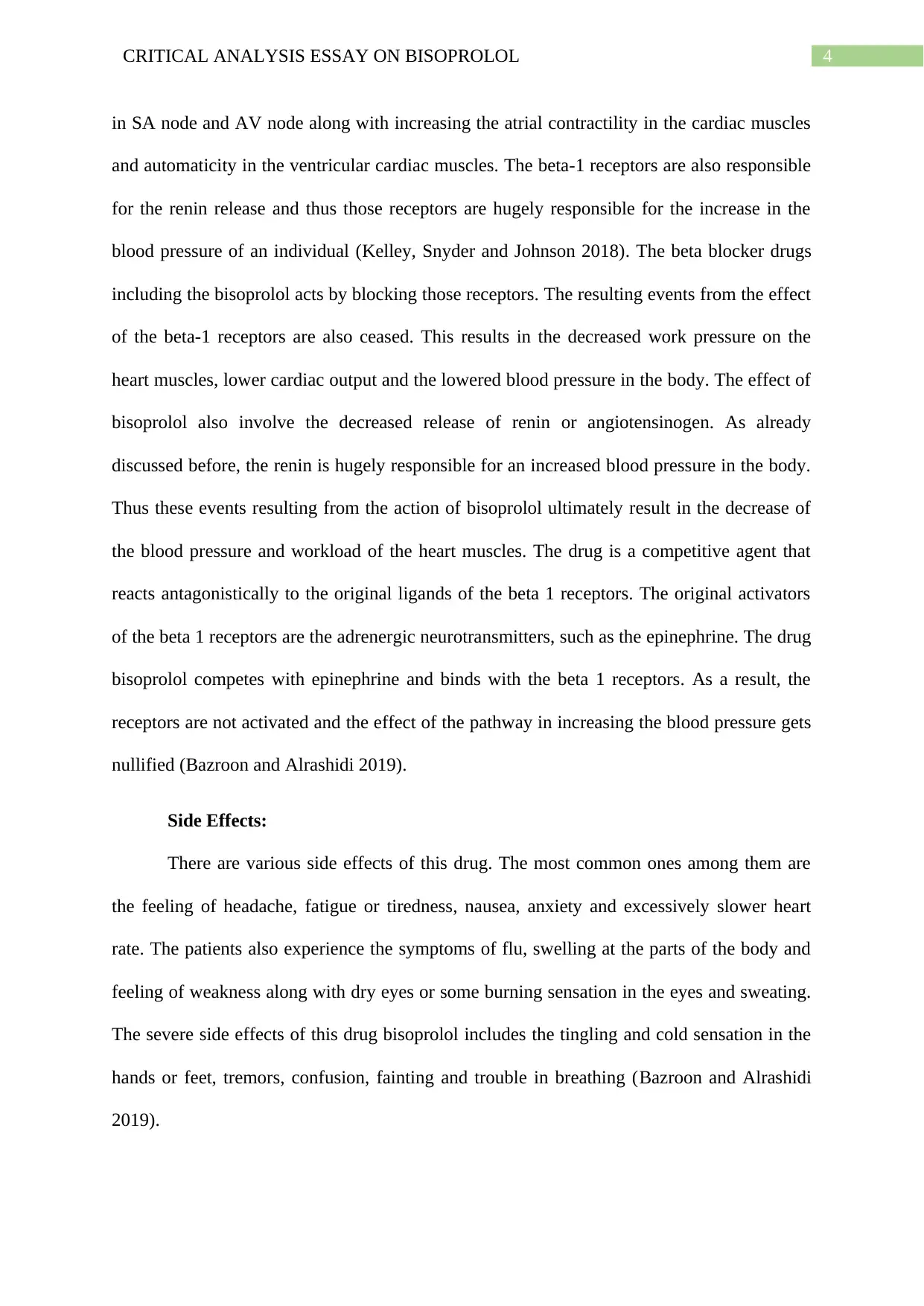
4CRITICAL ANALYSIS ESSAY ON BISOPROLOL
in SA node and AV node along with increasing the atrial contractility in the cardiac muscles
and automaticity in the ventricular cardiac muscles. The beta-1 receptors are also responsible
for the renin release and thus those receptors are hugely responsible for the increase in the
blood pressure of an individual (Kelley, Snyder and Johnson 2018). The beta blocker drugs
including the bisoprolol acts by blocking those receptors. The resulting events from the effect
of the beta-1 receptors are also ceased. This results in the decreased work pressure on the
heart muscles, lower cardiac output and the lowered blood pressure in the body. The effect of
bisoprolol also involve the decreased release of renin or angiotensinogen. As already
discussed before, the renin is hugely responsible for an increased blood pressure in the body.
Thus these events resulting from the action of bisoprolol ultimately result in the decrease of
the blood pressure and workload of the heart muscles. The drug is a competitive agent that
reacts antagonistically to the original ligands of the beta 1 receptors. The original activators
of the beta 1 receptors are the adrenergic neurotransmitters, such as the epinephrine. The drug
bisoprolol competes with epinephrine and binds with the beta 1 receptors. As a result, the
receptors are not activated and the effect of the pathway in increasing the blood pressure gets
nullified (Bazroon and Alrashidi 2019).
Side Effects:
There are various side effects of this drug. The most common ones among them are
the feeling of headache, fatigue or tiredness, nausea, anxiety and excessively slower heart
rate. The patients also experience the symptoms of flu, swelling at the parts of the body and
feeling of weakness along with dry eyes or some burning sensation in the eyes and sweating.
The severe side effects of this drug bisoprolol includes the tingling and cold sensation in the
hands or feet, tremors, confusion, fainting and trouble in breathing (Bazroon and Alrashidi
2019).
in SA node and AV node along with increasing the atrial contractility in the cardiac muscles
and automaticity in the ventricular cardiac muscles. The beta-1 receptors are also responsible
for the renin release and thus those receptors are hugely responsible for the increase in the
blood pressure of an individual (Kelley, Snyder and Johnson 2018). The beta blocker drugs
including the bisoprolol acts by blocking those receptors. The resulting events from the effect
of the beta-1 receptors are also ceased. This results in the decreased work pressure on the
heart muscles, lower cardiac output and the lowered blood pressure in the body. The effect of
bisoprolol also involve the decreased release of renin or angiotensinogen. As already
discussed before, the renin is hugely responsible for an increased blood pressure in the body.
Thus these events resulting from the action of bisoprolol ultimately result in the decrease of
the blood pressure and workload of the heart muscles. The drug is a competitive agent that
reacts antagonistically to the original ligands of the beta 1 receptors. The original activators
of the beta 1 receptors are the adrenergic neurotransmitters, such as the epinephrine. The drug
bisoprolol competes with epinephrine and binds with the beta 1 receptors. As a result, the
receptors are not activated and the effect of the pathway in increasing the blood pressure gets
nullified (Bazroon and Alrashidi 2019).
Side Effects:
There are various side effects of this drug. The most common ones among them are
the feeling of headache, fatigue or tiredness, nausea, anxiety and excessively slower heart
rate. The patients also experience the symptoms of flu, swelling at the parts of the body and
feeling of weakness along with dry eyes or some burning sensation in the eyes and sweating.
The severe side effects of this drug bisoprolol includes the tingling and cold sensation in the
hands or feet, tremors, confusion, fainting and trouble in breathing (Bazroon and Alrashidi
2019).
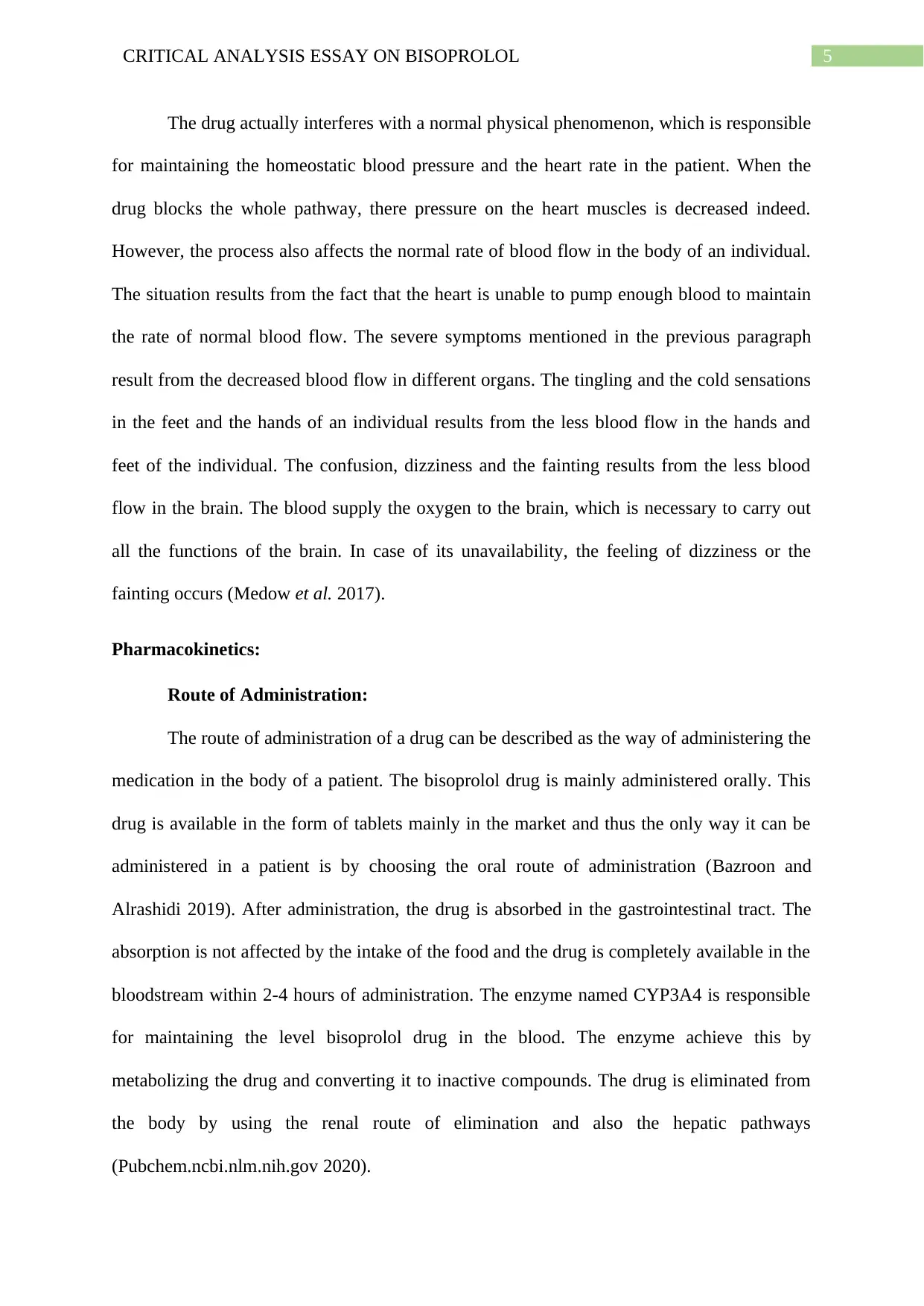
5CRITICAL ANALYSIS ESSAY ON BISOPROLOL
The drug actually interferes with a normal physical phenomenon, which is responsible
for maintaining the homeostatic blood pressure and the heart rate in the patient. When the
drug blocks the whole pathway, there pressure on the heart muscles is decreased indeed.
However, the process also affects the normal rate of blood flow in the body of an individual.
The situation results from the fact that the heart is unable to pump enough blood to maintain
the rate of normal blood flow. The severe symptoms mentioned in the previous paragraph
result from the decreased blood flow in different organs. The tingling and the cold sensations
in the feet and the hands of an individual results from the less blood flow in the hands and
feet of the individual. The confusion, dizziness and the fainting results from the less blood
flow in the brain. The blood supply the oxygen to the brain, which is necessary to carry out
all the functions of the brain. In case of its unavailability, the feeling of dizziness or the
fainting occurs (Medow et al. 2017).
Pharmacokinetics:
Route of Administration:
The route of administration of a drug can be described as the way of administering the
medication in the body of a patient. The bisoprolol drug is mainly administered orally. This
drug is available in the form of tablets mainly in the market and thus the only way it can be
administered in a patient is by choosing the oral route of administration (Bazroon and
Alrashidi 2019). After administration, the drug is absorbed in the gastrointestinal tract. The
absorption is not affected by the intake of the food and the drug is completely available in the
bloodstream within 2-4 hours of administration. The enzyme named CYP3A4 is responsible
for maintaining the level bisoprolol drug in the blood. The enzyme achieve this by
metabolizing the drug and converting it to inactive compounds. The drug is eliminated from
the body by using the renal route of elimination and also the hepatic pathways
(Pubchem.ncbi.nlm.nih.gov 2020).
The drug actually interferes with a normal physical phenomenon, which is responsible
for maintaining the homeostatic blood pressure and the heart rate in the patient. When the
drug blocks the whole pathway, there pressure on the heart muscles is decreased indeed.
However, the process also affects the normal rate of blood flow in the body of an individual.
The situation results from the fact that the heart is unable to pump enough blood to maintain
the rate of normal blood flow. The severe symptoms mentioned in the previous paragraph
result from the decreased blood flow in different organs. The tingling and the cold sensations
in the feet and the hands of an individual results from the less blood flow in the hands and
feet of the individual. The confusion, dizziness and the fainting results from the less blood
flow in the brain. The blood supply the oxygen to the brain, which is necessary to carry out
all the functions of the brain. In case of its unavailability, the feeling of dizziness or the
fainting occurs (Medow et al. 2017).
Pharmacokinetics:
Route of Administration:
The route of administration of a drug can be described as the way of administering the
medication in the body of a patient. The bisoprolol drug is mainly administered orally. This
drug is available in the form of tablets mainly in the market and thus the only way it can be
administered in a patient is by choosing the oral route of administration (Bazroon and
Alrashidi 2019). After administration, the drug is absorbed in the gastrointestinal tract. The
absorption is not affected by the intake of the food and the drug is completely available in the
bloodstream within 2-4 hours of administration. The enzyme named CYP3A4 is responsible
for maintaining the level bisoprolol drug in the blood. The enzyme achieve this by
metabolizing the drug and converting it to inactive compounds. The drug is eliminated from
the body by using the renal route of elimination and also the hepatic pathways
(Pubchem.ncbi.nlm.nih.gov 2020).
⊘ This is a preview!⊘
Do you want full access?
Subscribe today to unlock all pages.

Trusted by 1+ million students worldwide
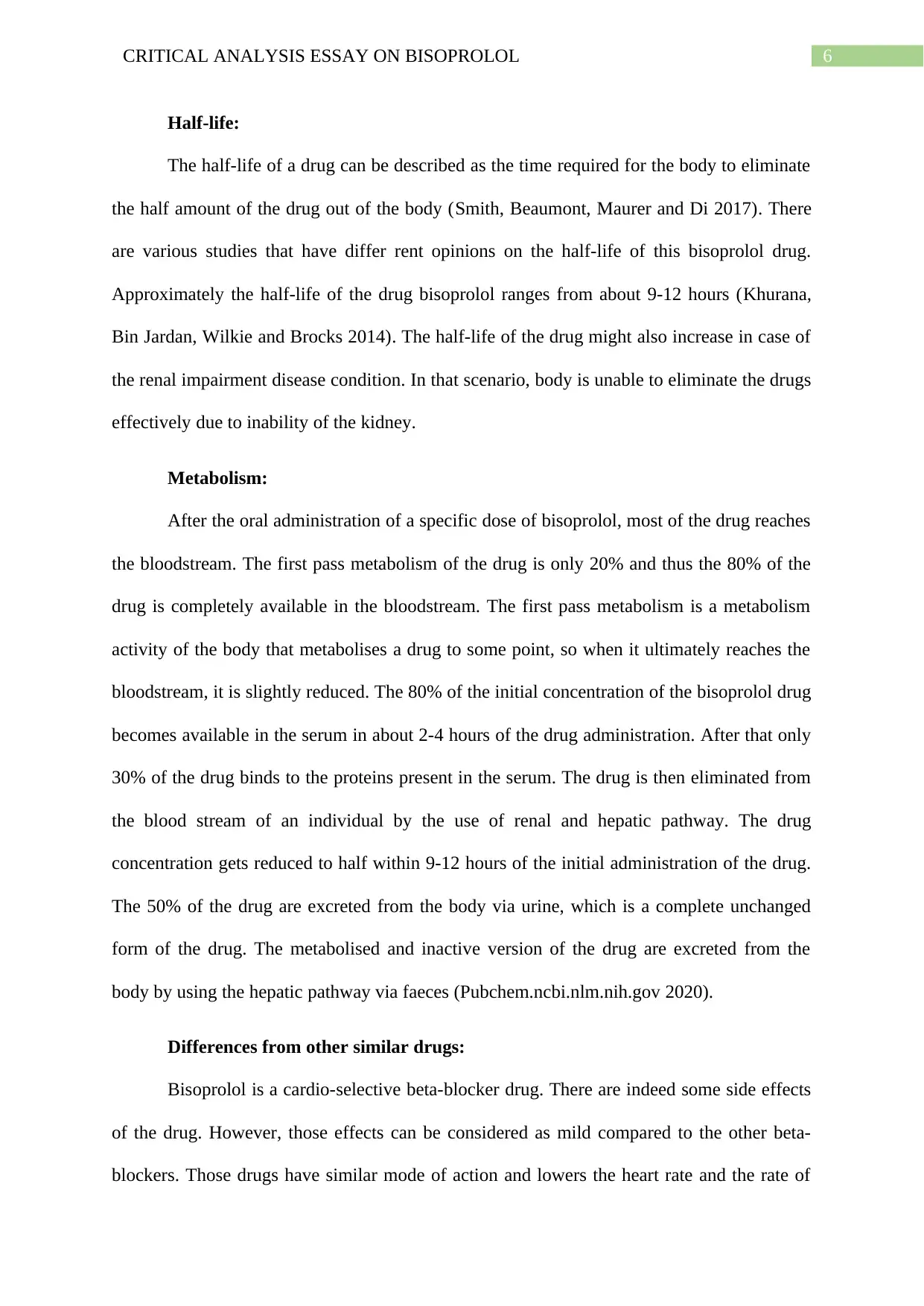
6CRITICAL ANALYSIS ESSAY ON BISOPROLOL
Half-life:
The half-life of a drug can be described as the time required for the body to eliminate
the half amount of the drug out of the body (Smith, Beaumont, Maurer and Di 2017). There
are various studies that have differ rent opinions on the half-life of this bisoprolol drug.
Approximately the half-life of the drug bisoprolol ranges from about 9-12 hours (Khurana,
Bin Jardan, Wilkie and Brocks 2014). The half-life of the drug might also increase in case of
the renal impairment disease condition. In that scenario, body is unable to eliminate the drugs
effectively due to inability of the kidney.
Metabolism:
After the oral administration of a specific dose of bisoprolol, most of the drug reaches
the bloodstream. The first pass metabolism of the drug is only 20% and thus the 80% of the
drug is completely available in the bloodstream. The first pass metabolism is a metabolism
activity of the body that metabolises a drug to some point, so when it ultimately reaches the
bloodstream, it is slightly reduced. The 80% of the initial concentration of the bisoprolol drug
becomes available in the serum in about 2-4 hours of the drug administration. After that only
30% of the drug binds to the proteins present in the serum. The drug is then eliminated from
the blood stream of an individual by the use of renal and hepatic pathway. The drug
concentration gets reduced to half within 9-12 hours of the initial administration of the drug.
The 50% of the drug are excreted from the body via urine, which is a complete unchanged
form of the drug. The metabolised and inactive version of the drug are excreted from the
body by using the hepatic pathway via faeces (Pubchem.ncbi.nlm.nih.gov 2020).
Differences from other similar drugs:
Bisoprolol is a cardio-selective beta-blocker drug. There are indeed some side effects
of the drug. However, those effects can be considered as mild compared to the other beta-
blockers. Those drugs have similar mode of action and lowers the heart rate and the rate of
Half-life:
The half-life of a drug can be described as the time required for the body to eliminate
the half amount of the drug out of the body (Smith, Beaumont, Maurer and Di 2017). There
are various studies that have differ rent opinions on the half-life of this bisoprolol drug.
Approximately the half-life of the drug bisoprolol ranges from about 9-12 hours (Khurana,
Bin Jardan, Wilkie and Brocks 2014). The half-life of the drug might also increase in case of
the renal impairment disease condition. In that scenario, body is unable to eliminate the drugs
effectively due to inability of the kidney.
Metabolism:
After the oral administration of a specific dose of bisoprolol, most of the drug reaches
the bloodstream. The first pass metabolism of the drug is only 20% and thus the 80% of the
drug is completely available in the bloodstream. The first pass metabolism is a metabolism
activity of the body that metabolises a drug to some point, so when it ultimately reaches the
bloodstream, it is slightly reduced. The 80% of the initial concentration of the bisoprolol drug
becomes available in the serum in about 2-4 hours of the drug administration. After that only
30% of the drug binds to the proteins present in the serum. The drug is then eliminated from
the blood stream of an individual by the use of renal and hepatic pathway. The drug
concentration gets reduced to half within 9-12 hours of the initial administration of the drug.
The 50% of the drug are excreted from the body via urine, which is a complete unchanged
form of the drug. The metabolised and inactive version of the drug are excreted from the
body by using the hepatic pathway via faeces (Pubchem.ncbi.nlm.nih.gov 2020).
Differences from other similar drugs:
Bisoprolol is a cardio-selective beta-blocker drug. There are indeed some side effects
of the drug. However, those effects can be considered as mild compared to the other beta-
blockers. Those drugs have similar mode of action and lowers the heart rate and the rate of
Paraphrase This Document
Need a fresh take? Get an instant paraphrase of this document with our AI Paraphraser
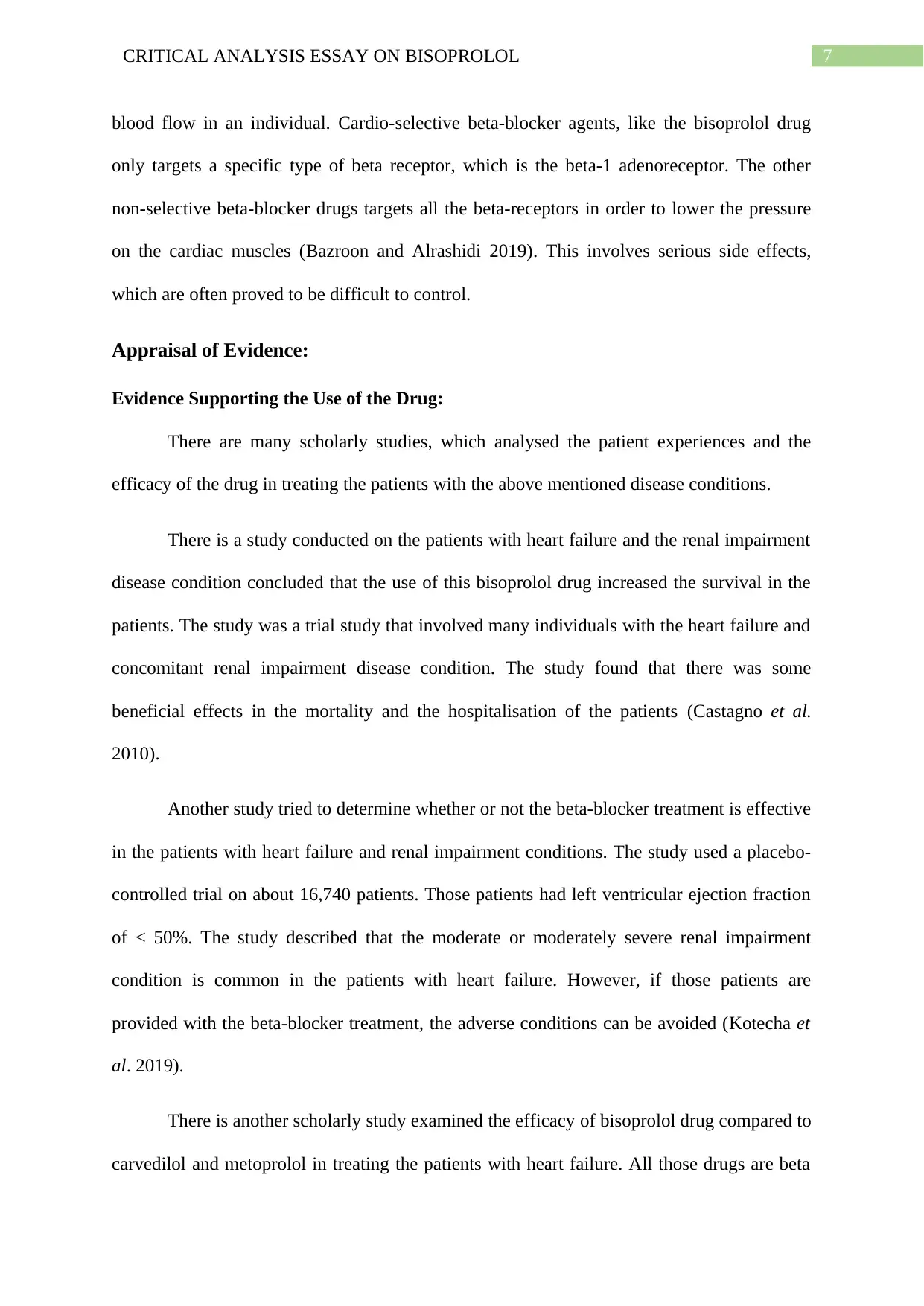
7CRITICAL ANALYSIS ESSAY ON BISOPROLOL
blood flow in an individual. Cardio-selective beta-blocker agents, like the bisoprolol drug
only targets a specific type of beta receptor, which is the beta-1 adenoreceptor. The other
non-selective beta-blocker drugs targets all the beta-receptors in order to lower the pressure
on the cardiac muscles (Bazroon and Alrashidi 2019). This involves serious side effects,
which are often proved to be difficult to control.
Appraisal of Evidence:
Evidence Supporting the Use of the Drug:
There are many scholarly studies, which analysed the patient experiences and the
efficacy of the drug in treating the patients with the above mentioned disease conditions.
There is a study conducted on the patients with heart failure and the renal impairment
disease condition concluded that the use of this bisoprolol drug increased the survival in the
patients. The study was a trial study that involved many individuals with the heart failure and
concomitant renal impairment disease condition. The study found that there was some
beneficial effects in the mortality and the hospitalisation of the patients (Castagno et al.
2010).
Another study tried to determine whether or not the beta-blocker treatment is effective
in the patients with heart failure and renal impairment conditions. The study used a placebo-
controlled trial on about 16,740 patients. Those patients had left ventricular ejection fraction
of < 50%. The study described that the moderate or moderately severe renal impairment
condition is common in the patients with heart failure. However, if those patients are
provided with the beta-blocker treatment, the adverse conditions can be avoided (Kotecha et
al. 2019).
There is another scholarly study examined the efficacy of bisoprolol drug compared to
carvedilol and metoprolol in treating the patients with heart failure. All those drugs are beta
blood flow in an individual. Cardio-selective beta-blocker agents, like the bisoprolol drug
only targets a specific type of beta receptor, which is the beta-1 adenoreceptor. The other
non-selective beta-blocker drugs targets all the beta-receptors in order to lower the pressure
on the cardiac muscles (Bazroon and Alrashidi 2019). This involves serious side effects,
which are often proved to be difficult to control.
Appraisal of Evidence:
Evidence Supporting the Use of the Drug:
There are many scholarly studies, which analysed the patient experiences and the
efficacy of the drug in treating the patients with the above mentioned disease conditions.
There is a study conducted on the patients with heart failure and the renal impairment
disease condition concluded that the use of this bisoprolol drug increased the survival in the
patients. The study was a trial study that involved many individuals with the heart failure and
concomitant renal impairment disease condition. The study found that there was some
beneficial effects in the mortality and the hospitalisation of the patients (Castagno et al.
2010).
Another study tried to determine whether or not the beta-blocker treatment is effective
in the patients with heart failure and renal impairment conditions. The study used a placebo-
controlled trial on about 16,740 patients. Those patients had left ventricular ejection fraction
of < 50%. The study described that the moderate or moderately severe renal impairment
condition is common in the patients with heart failure. However, if those patients are
provided with the beta-blocker treatment, the adverse conditions can be avoided (Kotecha et
al. 2019).
There is another scholarly study examined the efficacy of bisoprolol drug compared to
carvedilol and metoprolol in treating the patients with heart failure. All those drugs are beta
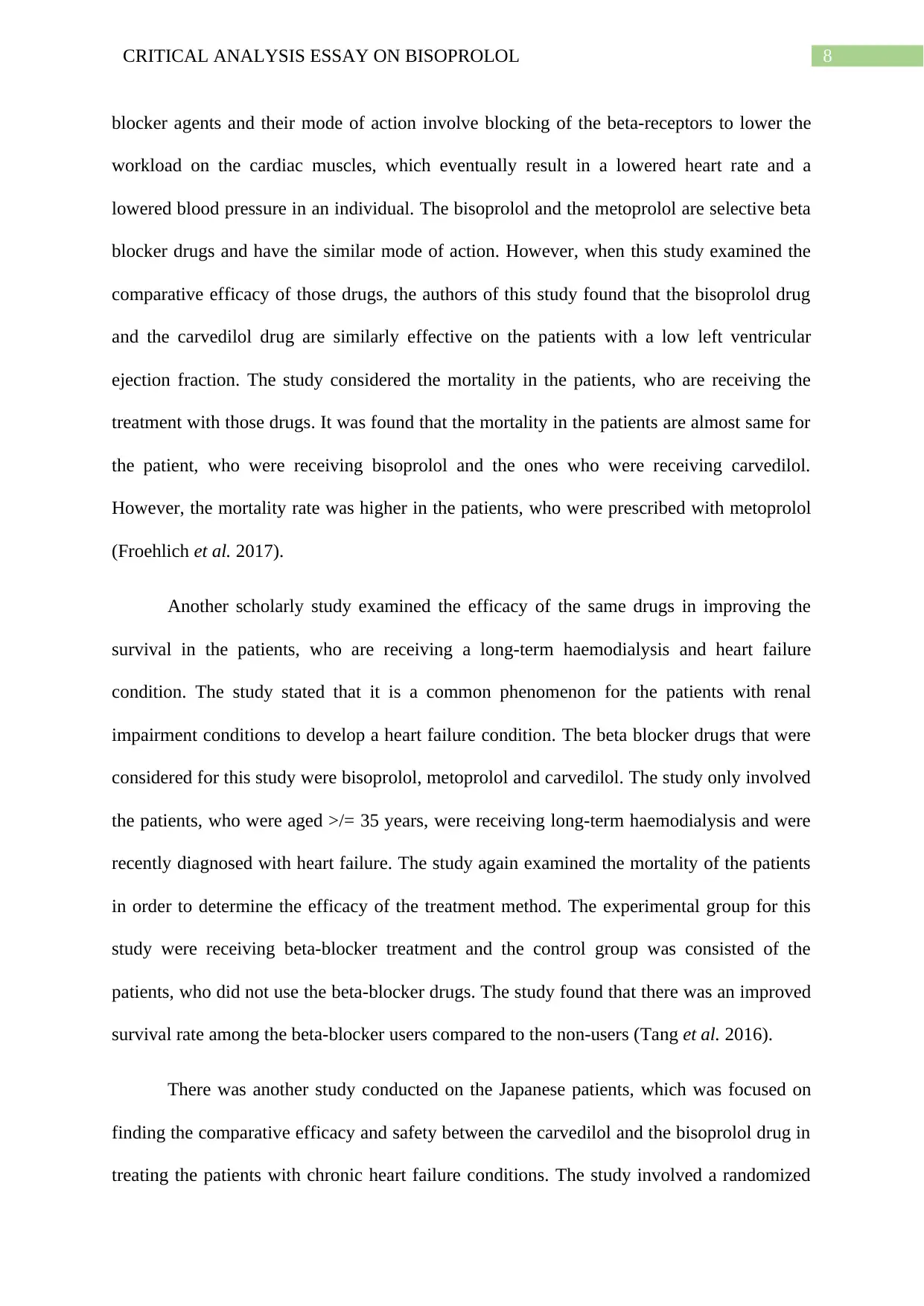
8CRITICAL ANALYSIS ESSAY ON BISOPROLOL
blocker agents and their mode of action involve blocking of the beta-receptors to lower the
workload on the cardiac muscles, which eventually result in a lowered heart rate and a
lowered blood pressure in an individual. The bisoprolol and the metoprolol are selective beta
blocker drugs and have the similar mode of action. However, when this study examined the
comparative efficacy of those drugs, the authors of this study found that the bisoprolol drug
and the carvedilol drug are similarly effective on the patients with a low left ventricular
ejection fraction. The study considered the mortality in the patients, who are receiving the
treatment with those drugs. It was found that the mortality in the patients are almost same for
the patient, who were receiving bisoprolol and the ones who were receiving carvedilol.
However, the mortality rate was higher in the patients, who were prescribed with metoprolol
(Froehlich et al. 2017).
Another scholarly study examined the efficacy of the same drugs in improving the
survival in the patients, who are receiving a long-term haemodialysis and heart failure
condition. The study stated that it is a common phenomenon for the patients with renal
impairment conditions to develop a heart failure condition. The beta blocker drugs that were
considered for this study were bisoprolol, metoprolol and carvedilol. The study only involved
the patients, who were aged >/= 35 years, were receiving long-term haemodialysis and were
recently diagnosed with heart failure. The study again examined the mortality of the patients
in order to determine the efficacy of the treatment method. The experimental group for this
study were receiving beta-blocker treatment and the control group was consisted of the
patients, who did not use the beta-blocker drugs. The study found that there was an improved
survival rate among the beta-blocker users compared to the non-users (Tang et al. 2016).
There was another study conducted on the Japanese patients, which was focused on
finding the comparative efficacy and safety between the carvedilol and the bisoprolol drug in
treating the patients with chronic heart failure conditions. The study involved a randomized
blocker agents and their mode of action involve blocking of the beta-receptors to lower the
workload on the cardiac muscles, which eventually result in a lowered heart rate and a
lowered blood pressure in an individual. The bisoprolol and the metoprolol are selective beta
blocker drugs and have the similar mode of action. However, when this study examined the
comparative efficacy of those drugs, the authors of this study found that the bisoprolol drug
and the carvedilol drug are similarly effective on the patients with a low left ventricular
ejection fraction. The study considered the mortality in the patients, who are receiving the
treatment with those drugs. It was found that the mortality in the patients are almost same for
the patient, who were receiving bisoprolol and the ones who were receiving carvedilol.
However, the mortality rate was higher in the patients, who were prescribed with metoprolol
(Froehlich et al. 2017).
Another scholarly study examined the efficacy of the same drugs in improving the
survival in the patients, who are receiving a long-term haemodialysis and heart failure
condition. The study stated that it is a common phenomenon for the patients with renal
impairment conditions to develop a heart failure condition. The beta blocker drugs that were
considered for this study were bisoprolol, metoprolol and carvedilol. The study only involved
the patients, who were aged >/= 35 years, were receiving long-term haemodialysis and were
recently diagnosed with heart failure. The study again examined the mortality of the patients
in order to determine the efficacy of the treatment method. The experimental group for this
study were receiving beta-blocker treatment and the control group was consisted of the
patients, who did not use the beta-blocker drugs. The study found that there was an improved
survival rate among the beta-blocker users compared to the non-users (Tang et al. 2016).
There was another study conducted on the Japanese patients, which was focused on
finding the comparative efficacy and safety between the carvedilol and the bisoprolol drug in
treating the patients with chronic heart failure conditions. The study involved a randomized
⊘ This is a preview!⊘
Do you want full access?
Subscribe today to unlock all pages.

Trusted by 1+ million students worldwide
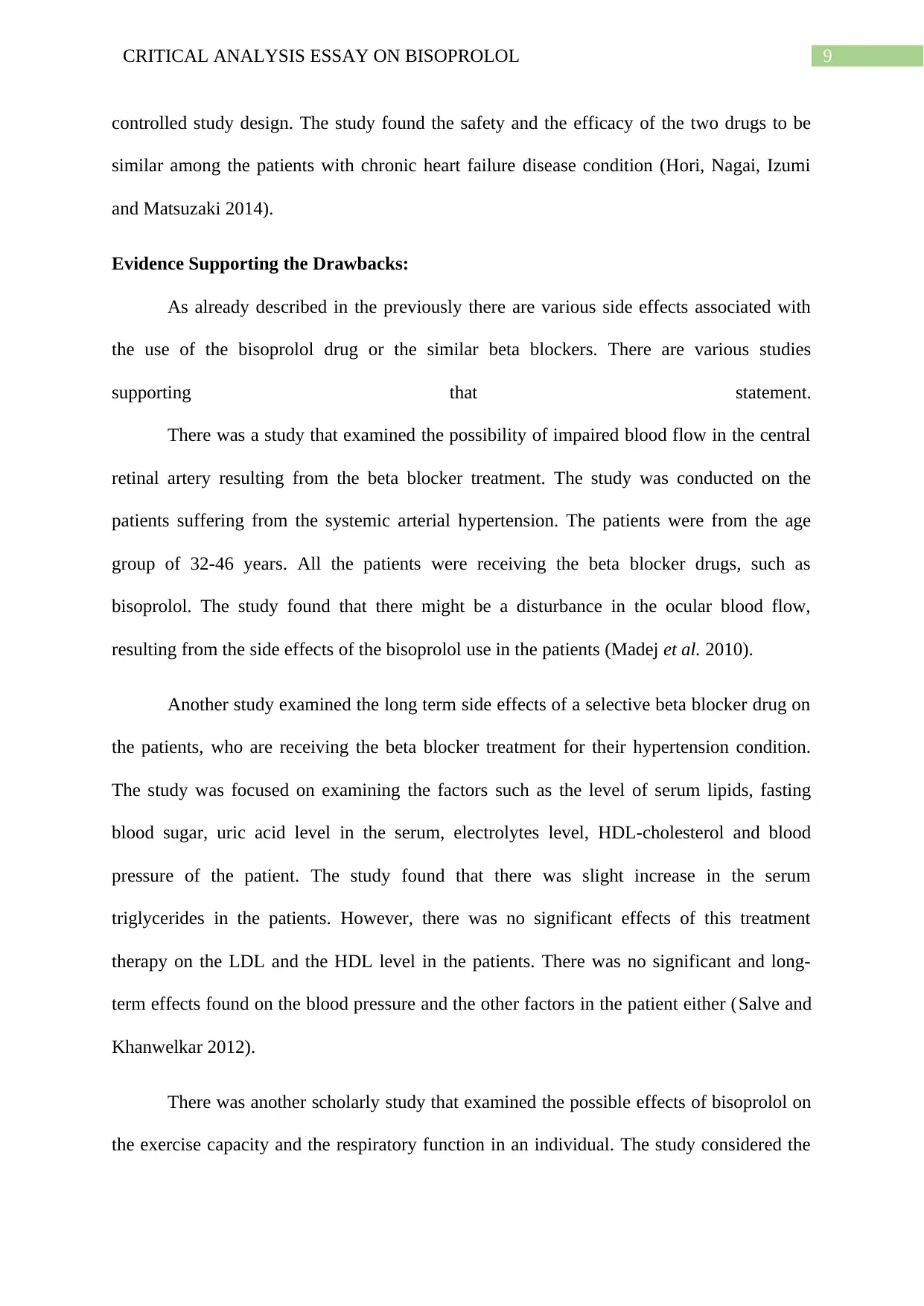
9CRITICAL ANALYSIS ESSAY ON BISOPROLOL
controlled study design. The study found the safety and the efficacy of the two drugs to be
similar among the patients with chronic heart failure disease condition (Hori, Nagai, Izumi
and Matsuzaki 2014).
Evidence Supporting the Drawbacks:
As already described in the previously there are various side effects associated with
the use of the bisoprolol drug or the similar beta blockers. There are various studies
supporting that statement.
There was a study that examined the possibility of impaired blood flow in the central
retinal artery resulting from the beta blocker treatment. The study was conducted on the
patients suffering from the systemic arterial hypertension. The patients were from the age
group of 32-46 years. All the patients were receiving the beta blocker drugs, such as
bisoprolol. The study found that there might be a disturbance in the ocular blood flow,
resulting from the side effects of the bisoprolol use in the patients (Madej et al. 2010).
Another study examined the long term side effects of a selective beta blocker drug on
the patients, who are receiving the beta blocker treatment for their hypertension condition.
The study was focused on examining the factors such as the level of serum lipids, fasting
blood sugar, uric acid level in the serum, electrolytes level, HDL-cholesterol and blood
pressure of the patient. The study found that there was slight increase in the serum
triglycerides in the patients. However, there was no significant effects of this treatment
therapy on the LDL and the HDL level in the patients. There was no significant and long-
term effects found on the blood pressure and the other factors in the patient either (Salve and
Khanwelkar 2012).
There was another scholarly study that examined the possible effects of bisoprolol on
the exercise capacity and the respiratory function in an individual. The study considered the
controlled study design. The study found the safety and the efficacy of the two drugs to be
similar among the patients with chronic heart failure disease condition (Hori, Nagai, Izumi
and Matsuzaki 2014).
Evidence Supporting the Drawbacks:
As already described in the previously there are various side effects associated with
the use of the bisoprolol drug or the similar beta blockers. There are various studies
supporting that statement.
There was a study that examined the possibility of impaired blood flow in the central
retinal artery resulting from the beta blocker treatment. The study was conducted on the
patients suffering from the systemic arterial hypertension. The patients were from the age
group of 32-46 years. All the patients were receiving the beta blocker drugs, such as
bisoprolol. The study found that there might be a disturbance in the ocular blood flow,
resulting from the side effects of the bisoprolol use in the patients (Madej et al. 2010).
Another study examined the long term side effects of a selective beta blocker drug on
the patients, who are receiving the beta blocker treatment for their hypertension condition.
The study was focused on examining the factors such as the level of serum lipids, fasting
blood sugar, uric acid level in the serum, electrolytes level, HDL-cholesterol and blood
pressure of the patient. The study found that there was slight increase in the serum
triglycerides in the patients. However, there was no significant effects of this treatment
therapy on the LDL and the HDL level in the patients. There was no significant and long-
term effects found on the blood pressure and the other factors in the patient either (Salve and
Khanwelkar 2012).
There was another scholarly study that examined the possible effects of bisoprolol on
the exercise capacity and the respiratory function in an individual. The study considered the
Paraphrase This Document
Need a fresh take? Get an instant paraphrase of this document with our AI Paraphraser
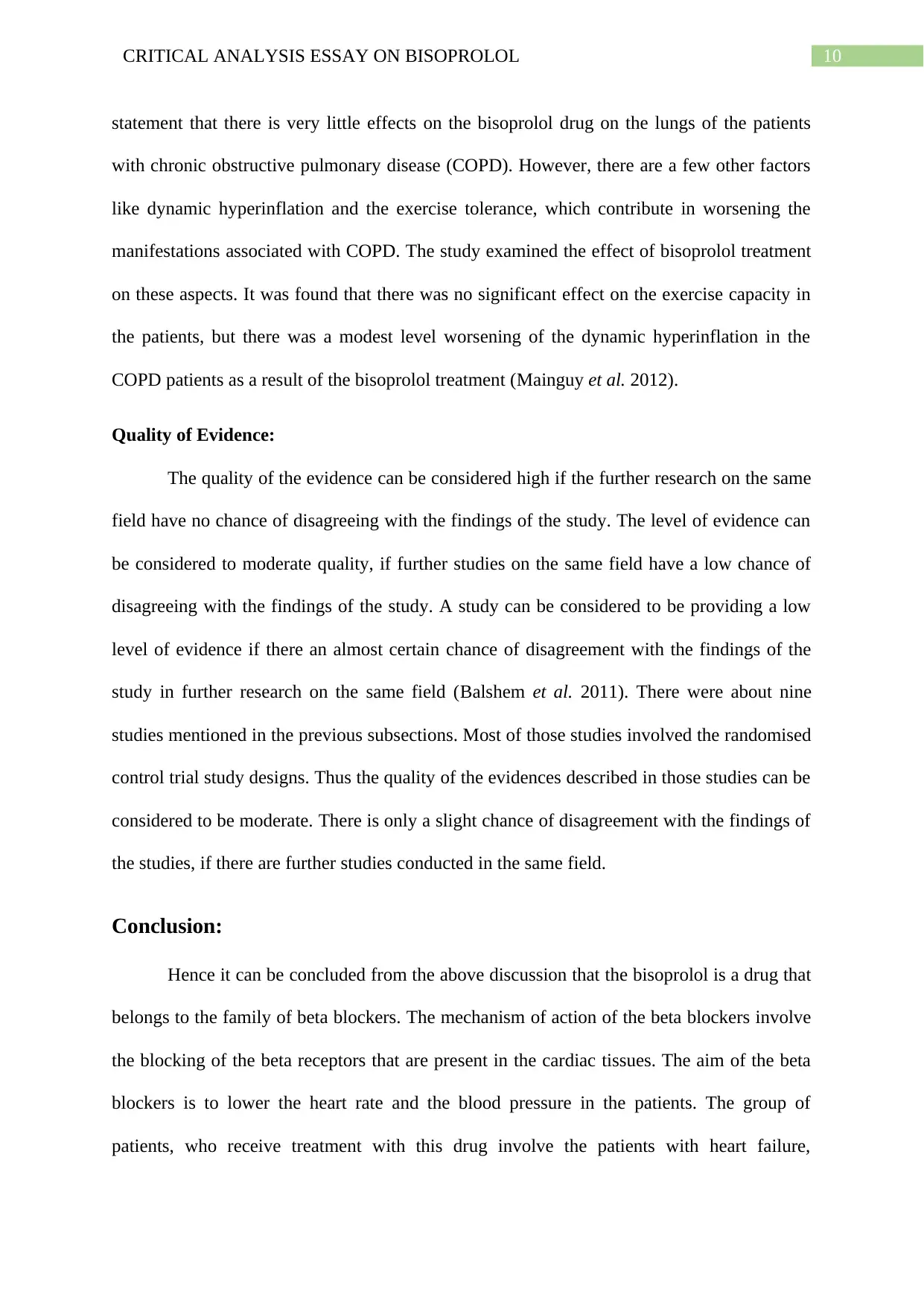
10CRITICAL ANALYSIS ESSAY ON BISOPROLOL
statement that there is very little effects on the bisoprolol drug on the lungs of the patients
with chronic obstructive pulmonary disease (COPD). However, there are a few other factors
like dynamic hyperinflation and the exercise tolerance, which contribute in worsening the
manifestations associated with COPD. The study examined the effect of bisoprolol treatment
on these aspects. It was found that there was no significant effect on the exercise capacity in
the patients, but there was a modest level worsening of the dynamic hyperinflation in the
COPD patients as a result of the bisoprolol treatment (Mainguy et al. 2012).
Quality of Evidence:
The quality of the evidence can be considered high if the further research on the same
field have no chance of disagreeing with the findings of the study. The level of evidence can
be considered to moderate quality, if further studies on the same field have a low chance of
disagreeing with the findings of the study. A study can be considered to be providing a low
level of evidence if there an almost certain chance of disagreement with the findings of the
study in further research on the same field (Balshem et al. 2011). There were about nine
studies mentioned in the previous subsections. Most of those studies involved the randomised
control trial study designs. Thus the quality of the evidences described in those studies can be
considered to be moderate. There is only a slight chance of disagreement with the findings of
the studies, if there are further studies conducted in the same field.
Conclusion:
Hence it can be concluded from the above discussion that the bisoprolol is a drug that
belongs to the family of beta blockers. The mechanism of action of the beta blockers involve
the blocking of the beta receptors that are present in the cardiac tissues. The aim of the beta
blockers is to lower the heart rate and the blood pressure in the patients. The group of
patients, who receive treatment with this drug involve the patients with heart failure,
statement that there is very little effects on the bisoprolol drug on the lungs of the patients
with chronic obstructive pulmonary disease (COPD). However, there are a few other factors
like dynamic hyperinflation and the exercise tolerance, which contribute in worsening the
manifestations associated with COPD. The study examined the effect of bisoprolol treatment
on these aspects. It was found that there was no significant effect on the exercise capacity in
the patients, but there was a modest level worsening of the dynamic hyperinflation in the
COPD patients as a result of the bisoprolol treatment (Mainguy et al. 2012).
Quality of Evidence:
The quality of the evidence can be considered high if the further research on the same
field have no chance of disagreeing with the findings of the study. The level of evidence can
be considered to moderate quality, if further studies on the same field have a low chance of
disagreeing with the findings of the study. A study can be considered to be providing a low
level of evidence if there an almost certain chance of disagreement with the findings of the
study in further research on the same field (Balshem et al. 2011). There were about nine
studies mentioned in the previous subsections. Most of those studies involved the randomised
control trial study designs. Thus the quality of the evidences described in those studies can be
considered to be moderate. There is only a slight chance of disagreement with the findings of
the studies, if there are further studies conducted in the same field.
Conclusion:
Hence it can be concluded from the above discussion that the bisoprolol is a drug that
belongs to the family of beta blockers. The mechanism of action of the beta blockers involve
the blocking of the beta receptors that are present in the cardiac tissues. The aim of the beta
blockers is to lower the heart rate and the blood pressure in the patients. The group of
patients, who receive treatment with this drug involve the patients with heart failure,
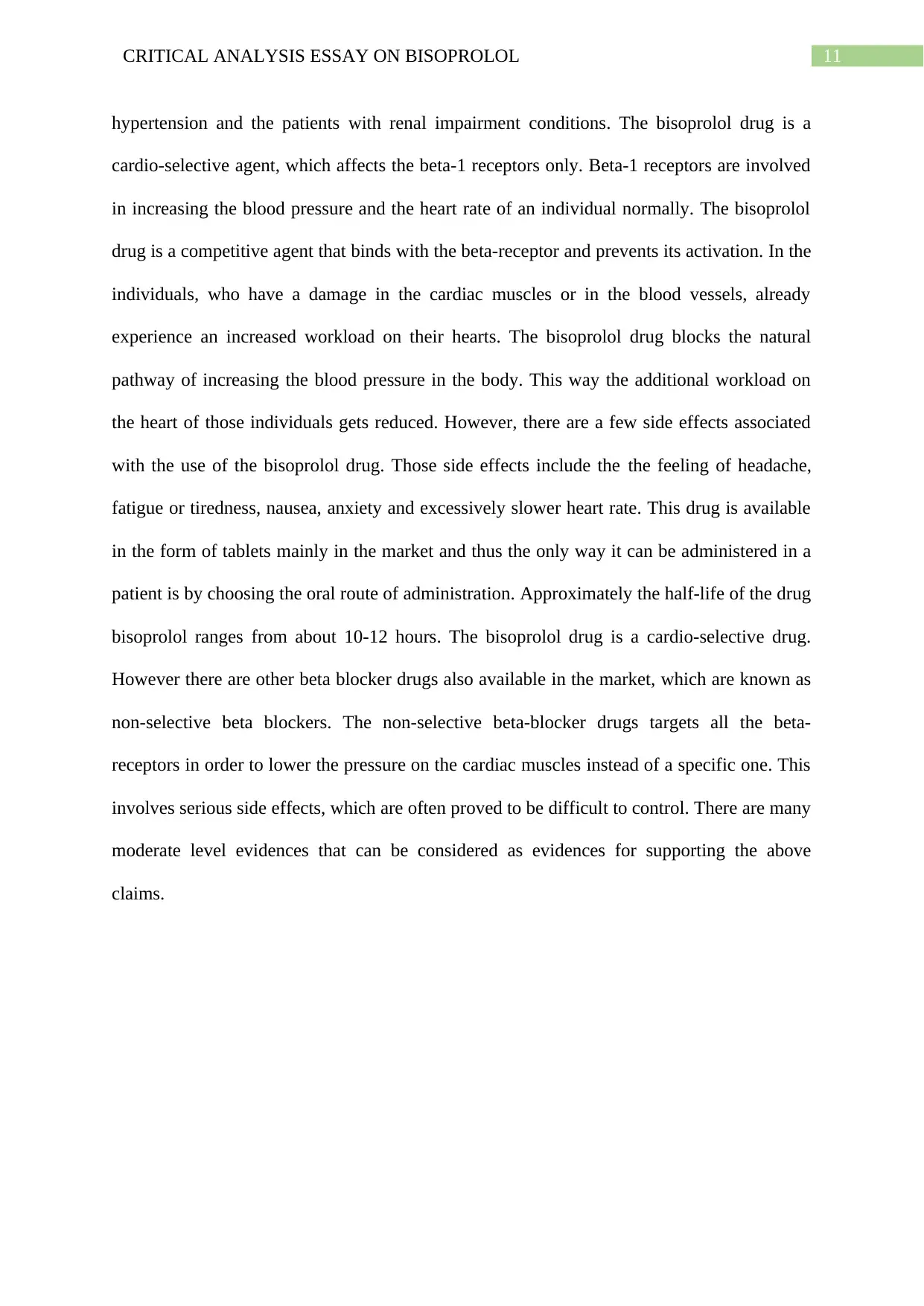
11CRITICAL ANALYSIS ESSAY ON BISOPROLOL
hypertension and the patients with renal impairment conditions. The bisoprolol drug is a
cardio-selective agent, which affects the beta-1 receptors only. Beta-1 receptors are involved
in increasing the blood pressure and the heart rate of an individual normally. The bisoprolol
drug is a competitive agent that binds with the beta-receptor and prevents its activation. In the
individuals, who have a damage in the cardiac muscles or in the blood vessels, already
experience an increased workload on their hearts. The bisoprolol drug blocks the natural
pathway of increasing the blood pressure in the body. This way the additional workload on
the heart of those individuals gets reduced. However, there are a few side effects associated
with the use of the bisoprolol drug. Those side effects include the the feeling of headache,
fatigue or tiredness, nausea, anxiety and excessively slower heart rate. This drug is available
in the form of tablets mainly in the market and thus the only way it can be administered in a
patient is by choosing the oral route of administration. Approximately the half-life of the drug
bisoprolol ranges from about 10-12 hours. The bisoprolol drug is a cardio-selective drug.
However there are other beta blocker drugs also available in the market, which are known as
non-selective beta blockers. The non-selective beta-blocker drugs targets all the beta-
receptors in order to lower the pressure on the cardiac muscles instead of a specific one. This
involves serious side effects, which are often proved to be difficult to control. There are many
moderate level evidences that can be considered as evidences for supporting the above
claims.
hypertension and the patients with renal impairment conditions. The bisoprolol drug is a
cardio-selective agent, which affects the beta-1 receptors only. Beta-1 receptors are involved
in increasing the blood pressure and the heart rate of an individual normally. The bisoprolol
drug is a competitive agent that binds with the beta-receptor and prevents its activation. In the
individuals, who have a damage in the cardiac muscles or in the blood vessels, already
experience an increased workload on their hearts. The bisoprolol drug blocks the natural
pathway of increasing the blood pressure in the body. This way the additional workload on
the heart of those individuals gets reduced. However, there are a few side effects associated
with the use of the bisoprolol drug. Those side effects include the the feeling of headache,
fatigue or tiredness, nausea, anxiety and excessively slower heart rate. This drug is available
in the form of tablets mainly in the market and thus the only way it can be administered in a
patient is by choosing the oral route of administration. Approximately the half-life of the drug
bisoprolol ranges from about 10-12 hours. The bisoprolol drug is a cardio-selective drug.
However there are other beta blocker drugs also available in the market, which are known as
non-selective beta blockers. The non-selective beta-blocker drugs targets all the beta-
receptors in order to lower the pressure on the cardiac muscles instead of a specific one. This
involves serious side effects, which are often proved to be difficult to control. There are many
moderate level evidences that can be considered as evidences for supporting the above
claims.
⊘ This is a preview!⊘
Do you want full access?
Subscribe today to unlock all pages.

Trusted by 1+ million students worldwide
1 out of 19
Related Documents
Your All-in-One AI-Powered Toolkit for Academic Success.
+13062052269
info@desklib.com
Available 24*7 on WhatsApp / Email
![[object Object]](/_next/static/media/star-bottom.7253800d.svg)
Unlock your academic potential
Copyright © 2020–2025 A2Z Services. All Rights Reserved. Developed and managed by ZUCOL.





